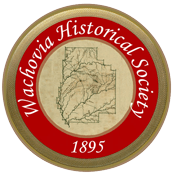Wachovia Historical Society Mission
“The object of this Society shall be the Collection, preservation, and dissemination of everything relating to the history, antiquities, and literature of the Moravian Church in the South and the secular and religious development in North Carolina and the adjoining states.”
— 1895 Constitution of the
Wachovia Historical Society
Today, we continue to be steered by this mission to discover what is unknown, preserve what is, and share this information with all.
Latest WHS News:
We have a lot of exciting and engaging things to come in 2025, so check back often as we add the latest news and events for the coming year!
Upcoming Guild Events
July 4th, 2025 , 8 am. Join your WHS fellows in the Salem Square for this recreation of the first Fourth of July Ceremony in America.
August 9th, 2025 1:30 – 4:30 pm. Historic Bethabara Park will host “Indigenous People and Moravians, a Celebration of Cultures.” This event offers a chance to learn about the Catawaba Nation and includes songs and dances presented by members of the Nation.
September 7,2025 Dr, Craig Atwood, Herrnhutt.
Look for the Zeffy blasts to WHS members for more information and to sign up for these events
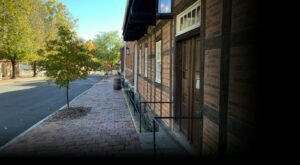
Reaching from the town of Bethania through Winston-Salem, N.C., Wachovia is a tract of land settled by Moravians in the mid 18th Century.
The area is steeped in history and traditions that reach back to the original settlers. Since then, a lot has changed in the area, while other sections are as they were over 275 years ago.
From early artifacts and buildings to modern-day development, the area is rich in historical resources that the Wachovia Historical Society proudly oversees.
Through this site, we wish to engage, inform, and even entertain you with everything that celebrates a history that will soon encompass 275 years!
Adam Spach Park Project
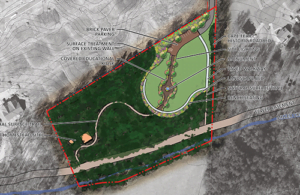 Wachovia Historical Society is moving forward with Phase II of the Adam Spach Historical Rock House Park. Quotations are being gathered for the park’s various elements, and grant applications will be submitted in the latter part of 2023. Construction on the park is expected to begin in early 2024, with completion sometime in the latter part of 2024. Click Here For More.
Wachovia Historical Society is moving forward with Phase II of the Adam Spach Historical Rock House Park. Quotations are being gathered for the park’s various elements, and grant applications will be submitted in the latter part of 2023. Construction on the park is expected to begin in early 2024, with completion sometime in the latter part of 2024. Click Here For More.
To learn more about the origins of the Adam Spach Park, click here.
Foltz Family Donates Special Gift
At a very appropriate time in the history of WHS, the Herman E. Foltz heirs have made a special gift to the Society in the form of the copyright to the book Adam and Maria Spach, Their Family; a chronicle of the descendants of Adam Spach from the first generation in 1753 with the birth of their first son, Johann Adam Spach, down to the current generation.
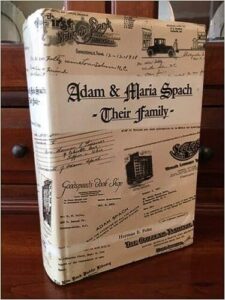 In addition to the copyright, the Herman Foltz heirs, Susan L. Foltz and Lynne Foltz Bostick have donated 28 of the remaining numbered First Edition copies of the book to the Society. The book, comprised of 1,002 pages, also contains pictures of some of the descendants as early as the third generation and other important historical information of the settlement of the Friedberg area. The book comprises 1,002 pages and is an invaluable research tool for a family that was instrumental in the progress of the early Moravian settlements of Wachovia
In addition to the copyright, the Herman Foltz heirs, Susan L. Foltz and Lynne Foltz Bostick have donated 28 of the remaining numbered First Edition copies of the book to the Society. The book, comprised of 1,002 pages, also contains pictures of some of the descendants as early as the third generation and other important historical information of the settlement of the Friedberg area. The book comprises 1,002 pages and is an invaluable research tool for a family that was instrumental in the progress of the early Moravian settlements of Wachovia
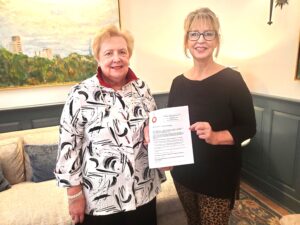
Susan Foltz presents copyright to President Michelle DeLapp.
Herman Foltz spent the remaining 30 years of his life traveling all over the country gathering genealogies, pictures, and information in the day before computers came onto the scene for research. The book was published in 1999 and the following year Mr. Foltz passed away. Wachovia Historical Society, Inc. expresses its deepest appreciation for the gift of this work which will be used by researchers and family members alike for generations to come.
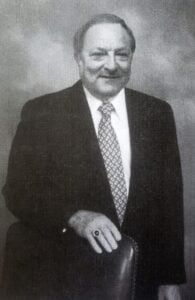
Herman Foltz
Proceeds from the sale of the remaining 28 copies of Adam and Maria Spach, Their Family; will go toward the Adam and Maria Spach Park Project currently underway. To order a copy, please click below:
Upper level dining room in the 1784 Salem Tavern owned by Wachovia Historical Society and interpreted by Old Salem Museums & Gardens.
(Photo courtesy Old Salem Museums & Gardens)
Spectacles worn by one of the founders of Hopewell Moravian Church, Henry Rippel (1758-1855), in 1802.
(Collection of WHS Acc # S-183; Photo courtesy Old Salem Museums & Gardens)
Lovefeast tray used in Salem, N.C. in the 19th century. (Collection of WHS Acc # T-177; Photo courtesy Old Salem Museums & Gardens)
Silk gauze gown made ca. 1822 that descended in the Vogler and Fries families.
(Collection of WHS Acc # G-138.8; Photo courtesy Old Salem Museums & Gardens)
Springerle rolling pin by made by Salem silversmith John Vogler (1783-1881) in 1824 for his wife Christina Vogler (1792-1863) to use when making springerle cookies.
(Collection of WHS Acc # M-137; Photo courtesy Old Salem Museums & Gardens)
